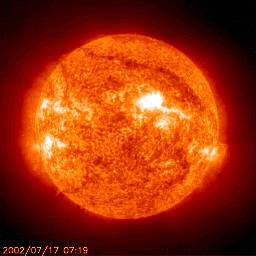Changes in luminosity are common to all stars, but the severity of such fluctuations covers a broad range. Most stars are relatively stable, but a significant minority of variable stars often undergo sudden and intense increases in luminosity and consequently in the amount of energy radiated toward bodies in orbit. These stars are considered poor candidates for hosting life-bearing planets, as their unpredictability and energy output changes would negatively impact organisms: living things adapted to a specific temperature range could not survive too great a temperature variation. Further, upswings in luminosity are generally accompanied by massive doses of gamma ray and X-ray radiation which might prove lethal. Atmospheres do mitigate such effects, but their atmosphere might not be retained by planets orbiting variables, because the high-frequency energy buffeting these planets would continually strip them of their protective covering.
The Sun, in this respect as in many others, is relatively benign: the variation between its maximum and minimum energy output is roughly 0.1% over its 11-year solar cycle. There is strong (though not undisputed) evidence that even minor changes in the Sun’s luminosity have had significant effects on the Earth’s climate well within the historical era: the Little Ice Age of the mid-second millennium, for instance, may have been caused by a relatively long-term decline in the Sun’s luminosity. Thus, a star does not have to be a true variable for differences in luminosity to affect habitability. Of known solar analogs, one that closely resembles the Sun is considered to be 18 Scorpii; unfortunately for the prospects of life existing in its proximity, the only significant difference between the two bodies is the amplitude of the solar cycle, which appears to be much greater for 18 Scorpii.
